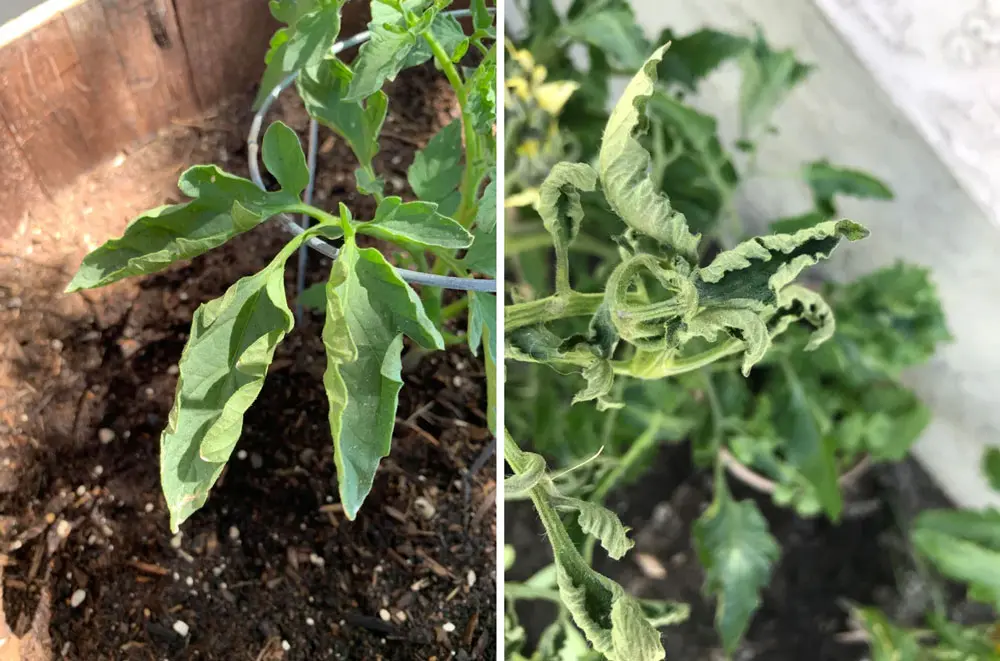Artichokes grow best in areas with long mild winters and cool summers. Artichokes do not grow well where the summers are sweltering, and where winters are cold and the ground freezes, artichokes must be replanted each year. Perennial artichokes should be cut back to about 12 inches in winter and the roots and crown heavily mulched with leaves or compost. For artichoke growing tips see Artichoke Growing Success Tips at the bottom of this post.
If you’ve noticed the leaves of your artichoke plant curling or rolling, you’re probably wondering what’s causing this unusual symptom. Curled leaves on artichokes can result from a few different issues, most related to environmental stresses. With some adjustments to care, you can get your plants looking healthy again.
What Causes Artichoke Leaves to Curl?
Here are some of the most common reasons for curling artichoke leaves:
Insufficient Watering
Artichokes require constant moisture for best growth. If soil dries out too much between waterings, the leaves will respond by curling inward to prevent excess transpiration water loss. Deep, infrequent watering can lead to periods of drought stress.
Under-Fertilization
Artichokes are heavy feeders that need regular fertilizer to thrive. Without adequate nutrients, the plants can become stressed. Slowed growth and curling leaves are signs that fertilization should be increased.
Extreme Temperatures
Intense heat and cold spells can shock artichoke plants Dramatic temperature swings cause the leaves to curl protectively Providing shade or cold frames helps buffer weather extremes.
Pests
Sucking insects like aphids can distort leaves as they feed Caterpillars and leaf miners burrowing into the leaves also cause curling and deformities Check for signs of infestation.
Diseases
Fungal diseases like verticillium wilt can infiltrate water-conducting plant tissues. This impedes water transport, leading to curled leaves. Early disease treatment is recommended.
Root Disturbance
If artichoke roots get damaged, such as by digging around the plant, it disrupts water uptake. The shocked plant reacts by curling its leaves. Avoid disturbing the root zone.
Excess Salt
Over-fertilizing with chemical nutrients or using salty water for irrigation can cause salt build-up in soil. To avoid absorbing excess salts through the roots, the plant curls its leaves.
How to Treat and Prevent Curled Leaves
Now that you know what causes leaf curl on artichokes, here are some tips to fix the problem and prevent future occurrences:
-
Water plants thoroughly 1-2 times per week, providing 1-2 inches of water each time. This encourages deep root growth.
-
Apply a balanced organic fertilizer every 3-4 weeks during the growing season to maintain nutrients.
-
Protect plants from temperature extremes by using row covers, shade cloth, or cold frames as needed.
-
Monitor for pests and treat promptly with organic methods like insecticidal soap, neem oil, or Bt-k.
-
Remove and destroy diseased plants to prevent spreading infection. Space plants properly for airflow.
-
Mulch around artichokes to maintain soil moisture and reduce watering needs.
-
Avoid over-fertilizing and use non-salty water if possible. Have soil tested to determine actual nutrient needs.
-
Prevent root damage by refraining from frequent digging around plants once they’re established.
-
Consider providing a trellis for support as the plants grow tall, preventing breakage.
-
Choose disease-resistant varieties suitable for your climate if curling is a recurring issue.
When to Worry about Curled Leaves
Mild curling of inner leaves is normal on artichokes as the plants grow. But if curling is excessive, spreads to all leaves, or is accompanied by wilting or yellowing, it likely indicates a bigger problem.
Make sure to rule out underlying pest, disease, and cultural issues. Leaf curling can progress to leaf necrosis and plant decline if left unchecked.
Monitor curled plants closely and be prepared to remove them if their condition is worsening. Providing ideal growing conditions can help distressed plants rebound. But those with major leaf curling may fail to thrive.
The Takeaway on Curled Artichoke Leaves
With their large leaves and big appetites, artichoke plants need plenty of water, nutrients, and care to achieve their full growth potential. If environmental factors fall short, the leaves respond by curling inward.
Pay close attention to your artichokes’ requirements and make adjustments as needed to get them back in top form. A little extra TLC can nourish your plants and have them unfurling their leaves again in no time!

Holes in stems and leaves; discolored spots on bracts
The larva of the artichoke plume moth is a ½-inch long green or yellowish caterpillar with black shield marks; the adult is a brownish moth with featherlike wings. Cut plants to soil level once a year; remove and destroy plant debris. Cover trimmed plants with 6 inches of soil. Using Bacillus thuringiensis and predaceous nematodes is effective.
Curled leaves, dwarfed plants; chokes are small and misshaped; yield is reduced by nearly half
The curly dwarf virus is usually spread in propagation from infected plants, not seeds. Remove and destroy infected plants immediately. Use virus-free stock for new plants. Control aphids which spread many viruses.
Why Are Your Bird Of Paradise Plant Leaves Curling?
FAQ
Why are my artichoke leaves curling?
How do you treat leaf curl disease?
Do curling leaves mean too much water?
